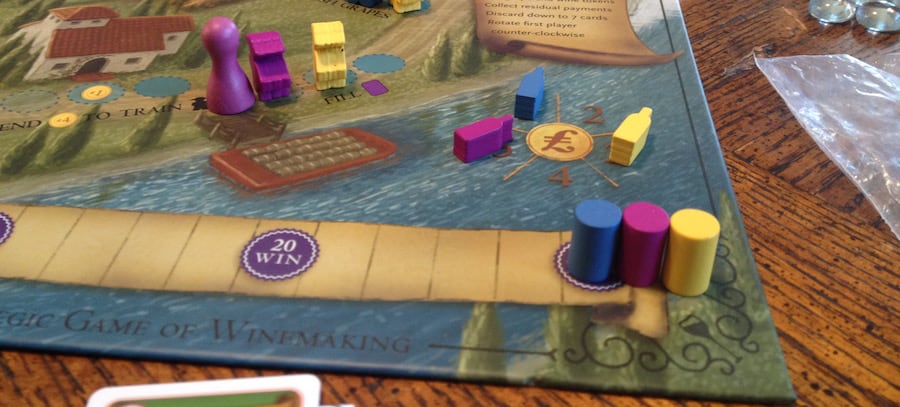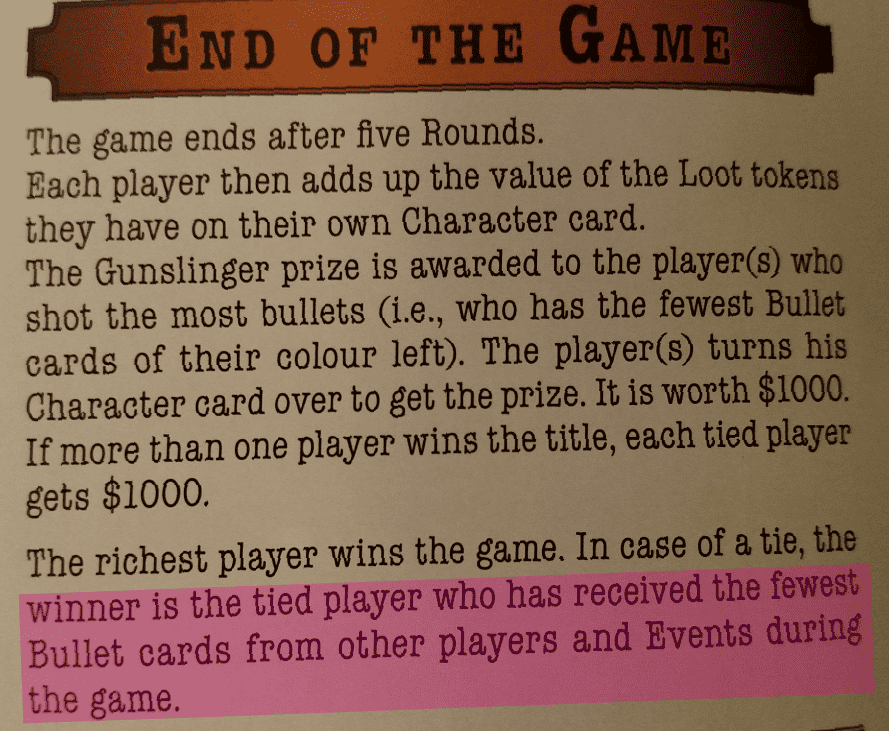
There are many ways to win a game. Some are a race ending when one player wins by achieving a desired condition first (Euphoria, Settlers of Catan). Some end with a single player being the last person standing and being declared the winner (Red Dragon Inn, Garbage Day). Some end with a player or players winning by completing a pre-specified objective before the other players (or the game) complete their objective (Battlestar Galactica, Pandemic). But in many games (I would even say most games) the winning player is the player who has collected the most of something: victory points, gold, resources, etc.
The problem with this method (as opposed to the others I mentioned) is that at the end of the game there is the possibility of more than one player having collected the same amount of that thing. So how do you, as a game designer, account for and design around the game ending in a tie? I’m going to give a little design advice on what I think makes a good tiebreaker, but I would love to hear from you as well on what you think goes into creating a great tiebreaking mechanism.
A TIEBREAKER SHOULD FOLLOW LOGICALLY FROM THE MAIN OBJECTIVE OF THE GAME
For many games the tiebreaker (if the number of victory points is tied) is just to go to another resource and whoever has the most of that resource (gold, gems, wood, etc) is the winner. However, too often I think this negates or fails to take into account what the overall objective of the game was. Take Viticulture for example. (author’s note: Viticulture is one of my favorite games and in my top 5 of all time, but I am going to criticize its tiebreaker a bit)

The tiebreaker in Viticulture is the player with the most money. However, to me the fundamental structure of Viticulture (how you get points) is fulfilling wine orders. Collecting money is merely a means to that end. The tiebreaker should be more closely tied to that fundamental structure.
There are many different paths that the designer could have gone down – player with the most wine orders fulfilled, player with the most wine in their cellar, player with the most wine and the most grapes, etc. All these reward a player for advancing down the path toward victory points (which is what wins you the game). By rewarding players for collecting coins, Viticulture goes outside of the main path of the game. A player should not be penalized just because they discovered a way to earn a lot of victory points outside of collecting a lot of money.
It makes sense that the tiebreaker should be more closely associated with the main objective of the game rather than its own side objective which can (in some ways) be at cross purposes to the main objective.
A TIEBREAKER SHOULD BE FINAL AND FIND A UNIQUE WINNER
I’m sure you’ve seen those games that say “The player with the most VP is the winner. If that is tied, the player with the most buildings is the winner. If that is tied, the player with the most gold is the winner. If that is tied, etc.” Sometimes a game will have 4-5 nested tiebreakers and then finally say the game ends in a tie. If you’re going to end the game in a tie anyway, just do it from the beginning. If you really want to break the tie, then find something that can’t possibly be tied and do that.

With Campaign Trail, we realized early on that in a 2 party game the number of states could not possibly be tied as there are 51 (including the District of Columbia) and that is not divisible by 2. So even if the electoral votes are tied, the tied player controlling the most number of states is the winner, and that’s the end of the tiebreaker chain.
In a 3 party game it was a little more complicated. That game can end in 2 players tied for most electoral votes and most number of states. But we figured out that due to the area control nature of the game, in that instance we could essentially remove the player in last place and give all their states to whoever held second place in them. This turns the game back into a 2 party game which cannot be tied on both electoral votes and number of states. This gives us a tiebreaker that cannot possibly go more than one layer deep.
I’ve seen other games solve this problem with things like using player turn order to break ties or having 1 particular token or building that only 1 player can control to break a tie or the player who took the fewest turns breaks the tie, etc. However, you tackle the problem, I would suggest not letting your tiebreakers go more than two layers deep.
A TIEBREAKER SHOULD BE THEMATIC
This follows closely with the first point but is slightly different. What I mean by this is the tiebreaker should fit within the theme of the game. For example when trying to decide the tiebreaker for Campaign Trail we thought of a number of different types of things that could potentially work – number of leftover registered voters, amount of money, amount of events in play, etc. While all of these have issues with point number 1 and 2, the other issue they have is, that’s not how it works in real life.
A candidate doesn’t get to be president by collecting the most money or registering the most voters. In real life if two candidates are tied the election goes to the House of Representatives where each state gets 1 vote. While we don’t have an actual House of Representatives, we can simulate the each state getting 1 vote part by saying if you control the state then its representatives would vote for you. Therefore whoever controls the most states wins.
Try to find something in the thematic context of your game to be the tiebreaker. Colt Express is an excellent example of a thematic tiebreaker. In real life as a bandit you don’t want to take a bullet and therefore the tied player with the fewest bullets wins the tiebreaker.

These are my three rules of tiebreaking. Let me know how you design tiebreakers. What criteria do you find most important?








